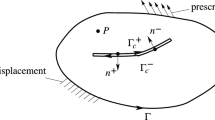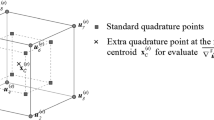Abstract
This paper presents a new dynamic crack growth prediction tool based upon the symmetric Galerkin boundary element method (SGBEM) in the Laplace domain, combined with the maximum hoop stress (MHS) criterion. The fast Laplace inverse transform developed by Durbin is employed to obtain time-domain solutions of the stress intensity factors required by the MHS criterion. In this work, the proposed Laplace SGBEM tool is used to predict crack trajectories in homogeneous and non-homogeneous isotropic brittle materials under dynamic loading conditions. The effect of the elastic constant mismatches is investigated for the influence of crack–inclusion interaction on crack growth.
Similar content being viewed by others
References
Aliabadi M.: The Boundary Element Method, Volume 2, Applications in Solids and Structures. Wiley, England (2002)
Banks-Sills L.: Application of the finite element method to linear elastic fracture mechanics. Appl. Mech. Rev. 44, 447–461 (1991)
Blandford G.E., Ingraffea A.R., Liggett J.A.: Two-dimensional stress intensity factor computations using the boundary element method. Int. J. Numer. Methods Eng. 17(3), 387–404 (1981)
Bonnet M.: Boundary Integral Equation Methods for Solids and Fluids. Wiley, England (1995)
Bonnet M., Maier G., Polizzotto C: On symmetric Galerkin boundary element method. ASME Appl. Mech. Rev. 51, 669–704 (1998)
Bush M.: The interaction between a crack and a particle cluster. Int. J. Fract. 88(3), 215–232 (1997)
Chirino F., Chirino F., Chirino F.: Dynamic analysis of cracks using boundary element method. Eng. Fract. Mech. 34, 1051–1061 (1989)
Durbin F.: Numerical inversion of laplace transforms: an efficient improvement to dubner and abate’s method. Comput. J. 17, 371–376 (1974)
Ebrahimi S., Phan A.-V.: Dynamic analysis of cracks using the (SGBEM) for elastodynamics in the laplace-space frequency domain. Eng. Anal. Bound. Elem. 37(11), 1378–1391 (2013)
Erdogan F., Sih G.: On the crack extension in plates under plane loading and transverse shear. J. Basic Eng. 85, 519 (1963)
Freund L.B.: Dynamic Fracture Mechanics. Cambridge University Press, Cambridge (1998)
Gray L.: Evaluation of hypersingular integrals in the boundary element method. Math. Comput. Model. 15, 165–174 (1991)
Gray L., Paulino G.: Symmetric galerkin boundary integral formulation for interface and multi-zone problems. Int. J. Numer. Methods Eng. 40, 3085–3101 (1997)
Gray L., Paulino G.: Crack tip interpolation, revisited. SIAM J. Appl. Math. 58, 428–455 (1998)
Gray L., Phan A.-V., Paulino G. H., Kaplan T.: Improved quarter-point crack tip element. Eng. Fract. Mech. 70(2), 269–283 (2003)
Huang, Y., Lei, J., Yang, Q.: Crack propagation in matrix with inclusions by bem. In: Mechatronics and Automation (ICMA), 2011 International Conference on (2011), IEEE, pp. 2270–2275
Ingraffea, A., Blandford, G., Ligget, J.: Automatic modelling of mixed-mode fatigue and quasi-static crack propagation using the boundary element method. In: Proceedings of Fracture Mechanics: Fourteenth Symposium, ASTM STP (1983), vol. 791, pp. 407–411
Kitey R., Phan A.-V., Tippur H., Kaplan T.: Modeling of crack growth through particulate clusters in brittle matrix by symmetric-Galerkin boundary element method. Int. J. Fract. 141(1–2), 11–25 (2006)
Knight M., Wrobel L., Henshall J., De Lacerda L.: A study of the interaction between a propagating crack and an uncoated coated elastic inclusion using the be technique. Int. J. Fract. 141(1–2), 47–61 (2002)
Krysl P., Belytschko T.: The element free Galerkin method for dynamic propagation of arbitrary 3D cracks. Int. J. Numer. Methods Eng. 44(6), 767–800 (1999)
Lei J., Wang Y.-S., Gross D.: Analysis of dynamic interaction between an inclusion and a nearby moving crack by BEM. Eng. Anal. Bound. Elem. 29(8), 802–813 (2005)
Lei J., Wang Y.-S., Huang Y., Yang Q., Zhang C.: Dynamic crack propagation in matrix involving inclusions by a time-domain {BEM}. Eng. Anal. Bound. Elem. 36(5), 651–657 (2012)
Lei J., Yang Q., Wang Y.-S., Zhang C.: An investigation of dynamic interaction between multiple cracks and inclusions by TDBEM. Compos. Sci. Technol. 69(7), 1279–1285 (2009)
Lei J., Zhang C., Yang Q., Wang Y.-S.: Dynamic effects of inclusions and microcracks on a main crack. Int. J. Fract. 164(2), 271–283 (2010)
Phan A.-V., Gray L. J., Kaplan T.: On some benchmark results for the interaction of a crack with a circular inclusion. Trans. ASME J. Appl. Mech. 74, 1282–1284 (2007)
Phan A.-V., Guduru V., Salvadori A., Gray L.: Frequency domain analysis by the exponential window method and SGBEM for elastodynamics. Comput. Mech. 48(5), 615–630 (2011)
Schädle A., López-Fernández M., Lubich C.: Fast and oblivious convolution quadrature. SIAM J. Sci. Comput. 28(2), 421–438 (2006)
Seelig T., Gross D.: Analysis of dynamic crack propagation using a time-domain boundary integral equation method. Int. J. Solids Struct. 34(17), 2087–2103 (1997)
Sutradhar A., Paulino G., Gray L.J.: Symmetric Galerkin Boundary Element Method. Springer, Berlin (2008)
Wang C., Libardi W., Baldo J.: Analysis of crack extension paths and toughening in a two phase brittle particulate composite by the boundary element method. Int. J. Fract. 94(2), 177–188 (1998)
Williams, M.L.: On the stress distribution at the base of a stationary crack. ASME J. Appl. Mech. 24, 111–114 (1957)
Williams R., Phan A.-V., Tippur H., Kaplan T., Gray L.: SGBEM analysis of crack–particle(s) interactions due to elastic constants mismatch. Eng. Fract. Mech. 74(3), 314–331 (2007)
Author information
Authors and Affiliations
Corresponding author
Rights and permissions
About this article
Cite this article
Ebrahimi, S., Phan, AV. Dynamic crack growth modeling technique based upon the SGBEM in the Laplace domain. Acta Mech 226, 769–781 (2015). https://doi.org/10.1007/s00707-014-1224-z
Received:
Revised:
Published:
Issue Date:
DOI: https://doi.org/10.1007/s00707-014-1224-z




